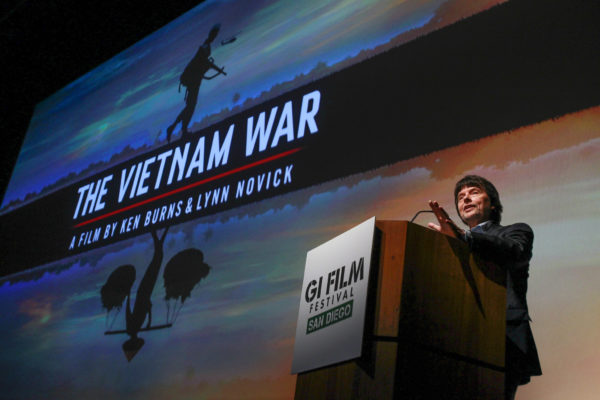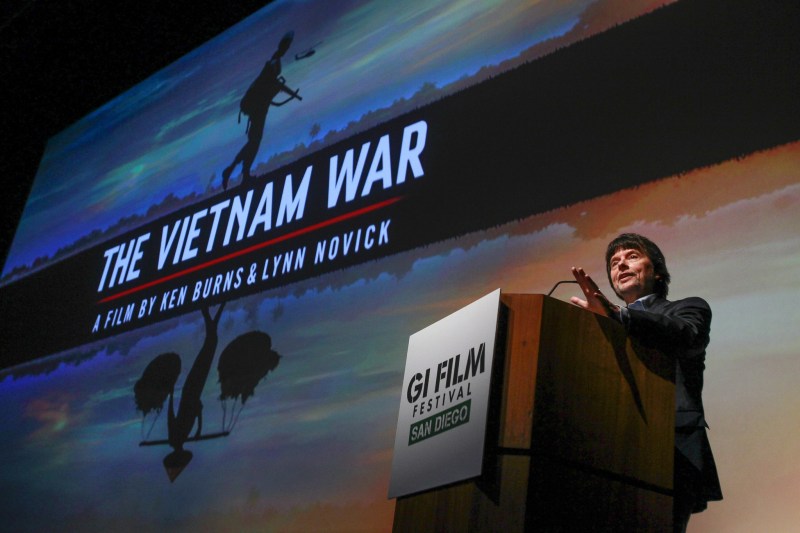
It’s only fitting that something with as many complex, confounding layers as the Vietnam War would receive coverage comprehensive enough to span an 18-hour documentary and a decade of interviews, research and analysis. With esteemed documentarian (hailed as “America’s Storyteller” by none other than Tom Hanks) Ken Burns and co-director Lynn Novick at the helm of this gargantuan project, they attempt to give the American public a holistic view of each layer that went into what is now commonly referred to as one of our country’s biggest mistakes. The most exciting part? The documentary is free to the public (airing on PBS), giving anybody the chance to explore the terror and heartache intertwined into that particular era of our history.
This summer, I attended “The Vietnam War: An Evening with Ken Burns and Lynn Novick” in my hometown of Kansas City, Missouri. The night consisted of screening eight intentionally selected clips of the documentary, which, at the time, had yet to air its first episode, followed by a Q&A with the directors and two additional collaborators on the film. The clips each lasted roughly 10 minutes and spanned a variety of topics, of which there are many to choose from with a historical event that carries with it a plethora of differing perspectives.
Each clip was made simply, lacking frills and dramatic gimmicks in an effort to let the stories from each interviewee (war veterans and ex-members of the Viet Cong were the central characters) retain all of their impact. Through consistent narration paired with iconic images of the time, news clips and footage on the battlefield, those unfamiliar with the war’s timeline were soon caught up to the most important events (both on and off U.S. soil), allowing for a greater appreciation and understanding of the emotional strife lurking behind every word of those interviewed.
The most powerful clip by a long shot had members of the Midwestern audience straining to hold themselves together. It was aired strategically at the end of the evening, so the testimonials given throughout the segment were from characters the audience had already been exposed to and consequently formed a relationship with, only serving to heighten the pain we felt at their turmoil. One by one, veterans of the war recounted their experiences approaching the Vietnam Veterans Memorial, a black marble scar sunken into the ground in Washington D.C. and etched with the almost 60,000 names of fallen family and friends. The audience had come to know each featured veteran as some of the most resilient individuals to ever come out of the U.S., so watching them break down in the face of reminders of fallen colleagues was, in a word, difficult. Ken Burns and his team were prepared for this reaction; each audience member was handed a pack of tissues upon entrance.
As I mentioned, the audience was from a Midwestern town, which, demographically, was predominantly white. The theater was filled with U.S. war veterans and their families. Having the story of the war told in such a comprehensive and accurate manner was incredibly meaningful for many veterans that evening, but I was left curious regarding the selection of clips shown and whether or not they were curated for this specific audience. The display of Western perspectives greatly outweighed the display of Vietnamese perspectives in the segment choices. As someone who lacked extensive knowledge about the war before entering the theater, I was left with a slight sense of imbalance.
This documentary is hard to watch for many, but that should be an encouraging rather than discouraging factor to future generations in choosing whether or not to dive down this 18-hour hole. The Vietnam War, for so many years not discussed around the family dinner table and not a common subject of discourse for young people unless studied with intention, is finally being brought into a light where it can be understood and digested by the masses. It’s a story that needs to be told, and an opportunity to learn that shouldn’t be wasted.
Contact Elizabeth Gerson at egerson ‘at’ stanford.edu.
